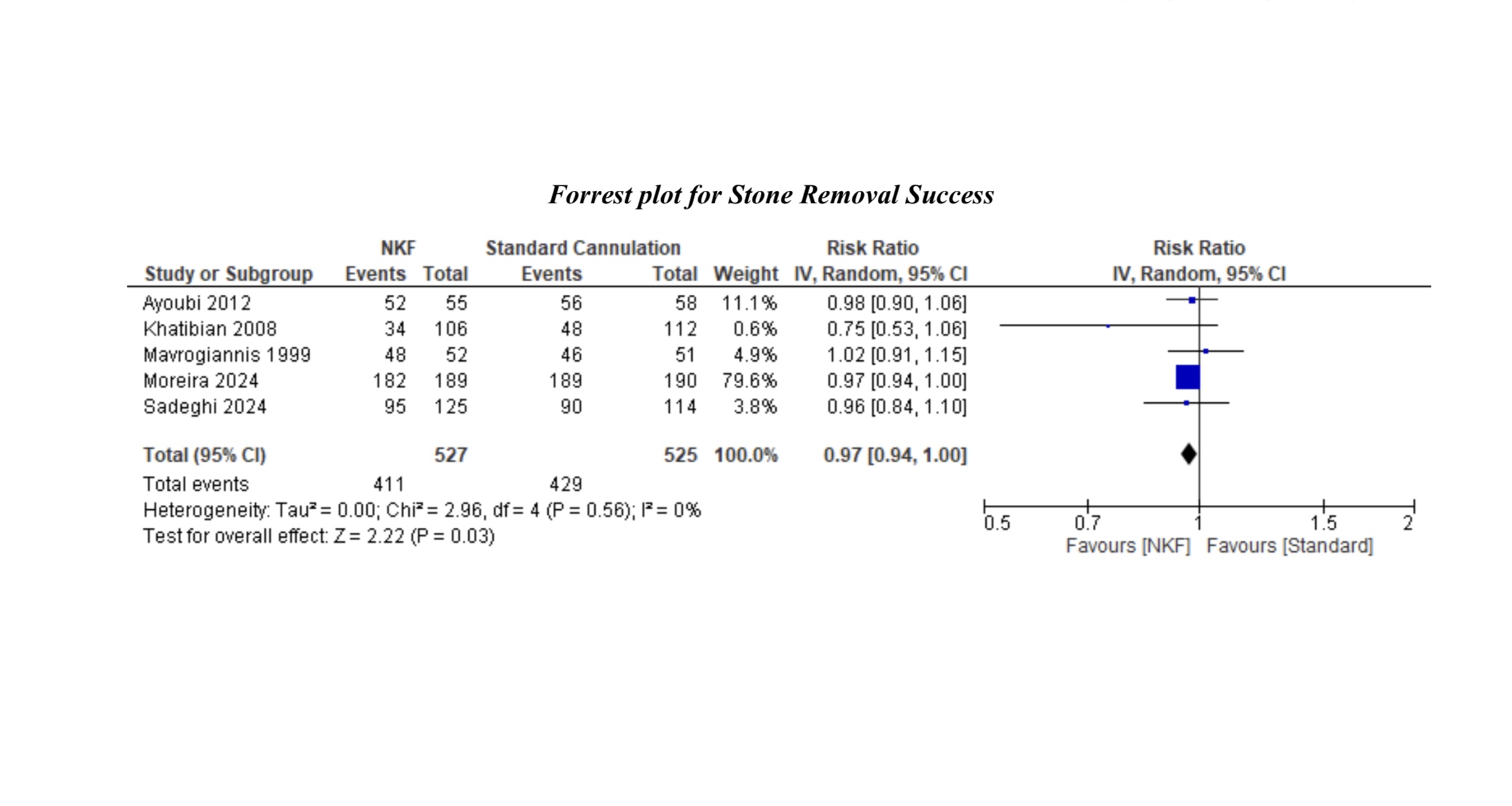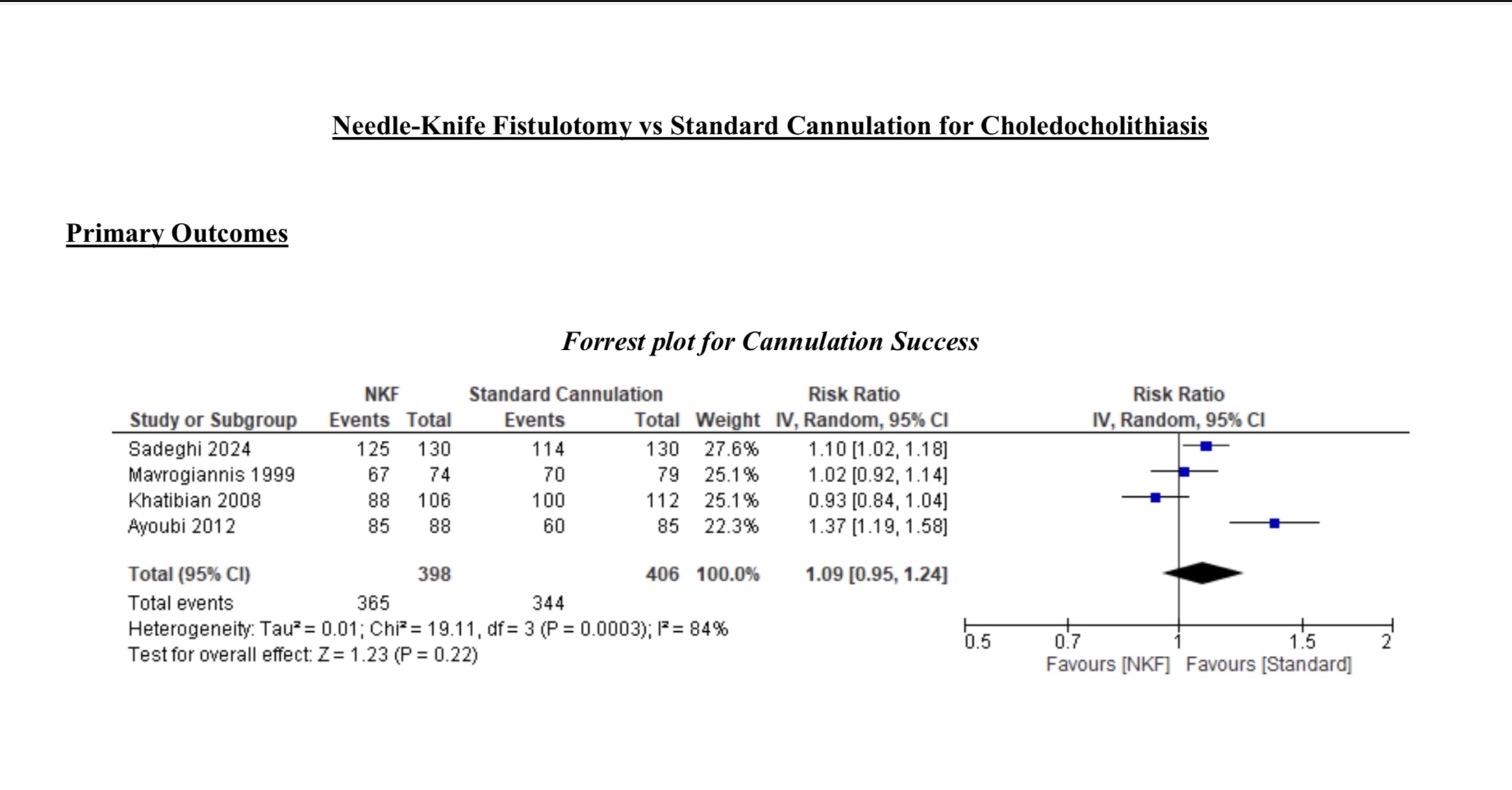Sunday Poster Session
Category: Interventional Endoscopy
P1369 - Comparing Needle-Knife Fistulotomy to Transpapillary Cannulation for Choledocholithiasis: A Meta-Analysis of Stone Clearance and Complication Rates
Sunday, October 26, 2025
3:30 PM - 7:00 PM PDT
Location: Exhibit Hall

Zainab Rafaqat, MD
University of Oklahoma Health Sciences Center
Oklahoma City, OK
Presenting Author(s)
Zainab Rafaqat, MD1, Muhammad Faiq Akram, MBBS2, Maria Ahsan, MBBS3, Bireera Muzafar, MD4, Kenneth C. Barnett, MD1, Maham Maqsood, MBBS2, Ijlal Akbar. Ali, MD5
1University of Oklahoma Health Sciences Center, Oklahoma City, OK; 2Allama Iqbal Medical College, Lahore, Lahore, Punjab, Pakistan; 3King Edward Medical University, Lahore, Punjab, Pakistan; 4College of Medicine, University of Oklahoma Health Sciences Center, Oklahoma City, OK; 5University of Oklahoma, Oklahoma City, OK
Introduction: Choledocholithiasis affects 10–20% of gallstone patients and is a leading cause of biliary obstruction worldwide. ERCP is the gold standard for bile duct stone removal, with success rates over 85–95%. Needle-knife fistulotomy (NKF), originally a rescue technique for difficult cannulation, is now increasingly considered as a primary approach due to promising safety and efficacy data. However, its comparative effectiveness versus standard cannulation for stone clearance remains unclear. This meta-analysis evaluates current evidence to determine if NKF offers equivalent success and complication rates in managing choledocholithiasis.
Methods: Following PRISMA, we searched Medline, PubMed, EMBASE, Cochrane Library, Google Scholar, and ClinicalTrials.gov for English RCTs and cohorts up to April 2025 comparing needle-knife fistulotomy (NKF) vs standard cannulation (SC) in ERCP for choledocholithiasis. Primary outcome was stone removal; secondary included cannulation success and complications. Six studies (2 RCTs, 4 cohorts) were analyzed using RevMan with effect models based on heterogeneity.
Results: A total of 1,333 patients from six studies (662 NKF, 671 SC) were analyzed. Stone clearance (RR 0.97, 95% CI: 0.94–1.00) and cannulation success (RR 1.09, 95% CI: 0.95–1.25) were comparable between groups, showing NKF is non-inferior to standard cannulation. Mean stone size showed no significant difference (mean difference 0.60 mm, 95% CI: –0.08 to 1.27). NKF patients had a higher, but non-significant, rate of repeat ERCP (RR 1.39, 95% CI: 0.89–2.16). Adverse events including pancreatitis, bleeding, perforation, and cholangitis,were similar. Biliary stent use was also comparable. Overall, NKF is non-inferior to standard cannulation in efficacy and safety.
Discussion: This meta-analysis demonstrates non inferiority of needle-knife fistulotomy (NKF) over standard transpapillary cannulation for stone clearance in choledocholithiasis. Although stone size may play a role in procedural success, this was not statistically significant in our analysis. Factors such as papillary morphology and procedural complexity could also influence outcomes. With growing evidence supporting NKF’s safety and efficacy, treatment decisions should be guided by careful pre-procedural assessment and risk stratification. Further studies are needed to clarify these factors and optimize patient selection for NKF.

Figure: Forest plot for stone removal success

Figure: Forest plot for cannulation success
Disclosures:
Zainab Rafaqat indicated no relevant financial relationships.
Muhammad Faiq Akram indicated no relevant financial relationships.
Maria Ahsan indicated no relevant financial relationships.
Bireera Muzafar indicated no relevant financial relationships.
Kenneth Barnett indicated no relevant financial relationships.
Maham Maqsood indicated no relevant financial relationships.
Ijlal Ali indicated no relevant financial relationships.
Zainab Rafaqat, MD1, Muhammad Faiq Akram, MBBS2, Maria Ahsan, MBBS3, Bireera Muzafar, MD4, Kenneth C. Barnett, MD1, Maham Maqsood, MBBS2, Ijlal Akbar. Ali, MD5. P1369 - Comparing Needle-Knife Fistulotomy to Transpapillary Cannulation for Choledocholithiasis: A Meta-Analysis of Stone Clearance and Complication Rates, ACG 2025 Annual Scientific Meeting Abstracts. Phoenix, AZ: American College of Gastroenterology.
1University of Oklahoma Health Sciences Center, Oklahoma City, OK; 2Allama Iqbal Medical College, Lahore, Lahore, Punjab, Pakistan; 3King Edward Medical University, Lahore, Punjab, Pakistan; 4College of Medicine, University of Oklahoma Health Sciences Center, Oklahoma City, OK; 5University of Oklahoma, Oklahoma City, OK
Introduction: Choledocholithiasis affects 10–20% of gallstone patients and is a leading cause of biliary obstruction worldwide. ERCP is the gold standard for bile duct stone removal, with success rates over 85–95%. Needle-knife fistulotomy (NKF), originally a rescue technique for difficult cannulation, is now increasingly considered as a primary approach due to promising safety and efficacy data. However, its comparative effectiveness versus standard cannulation for stone clearance remains unclear. This meta-analysis evaluates current evidence to determine if NKF offers equivalent success and complication rates in managing choledocholithiasis.
Methods: Following PRISMA, we searched Medline, PubMed, EMBASE, Cochrane Library, Google Scholar, and ClinicalTrials.gov for English RCTs and cohorts up to April 2025 comparing needle-knife fistulotomy (NKF) vs standard cannulation (SC) in ERCP for choledocholithiasis. Primary outcome was stone removal; secondary included cannulation success and complications. Six studies (2 RCTs, 4 cohorts) were analyzed using RevMan with effect models based on heterogeneity.
Results: A total of 1,333 patients from six studies (662 NKF, 671 SC) were analyzed. Stone clearance (RR 0.97, 95% CI: 0.94–1.00) and cannulation success (RR 1.09, 95% CI: 0.95–1.25) were comparable between groups, showing NKF is non-inferior to standard cannulation. Mean stone size showed no significant difference (mean difference 0.60 mm, 95% CI: –0.08 to 1.27). NKF patients had a higher, but non-significant, rate of repeat ERCP (RR 1.39, 95% CI: 0.89–2.16). Adverse events including pancreatitis, bleeding, perforation, and cholangitis,were similar. Biliary stent use was also comparable. Overall, NKF is non-inferior to standard cannulation in efficacy and safety.
Discussion: This meta-analysis demonstrates non inferiority of needle-knife fistulotomy (NKF) over standard transpapillary cannulation for stone clearance in choledocholithiasis. Although stone size may play a role in procedural success, this was not statistically significant in our analysis. Factors such as papillary morphology and procedural complexity could also influence outcomes. With growing evidence supporting NKF’s safety and efficacy, treatment decisions should be guided by careful pre-procedural assessment and risk stratification. Further studies are needed to clarify these factors and optimize patient selection for NKF.

Figure: Forest plot for stone removal success

Figure: Forest plot for cannulation success
Disclosures:
Zainab Rafaqat indicated no relevant financial relationships.
Muhammad Faiq Akram indicated no relevant financial relationships.
Maria Ahsan indicated no relevant financial relationships.
Bireera Muzafar indicated no relevant financial relationships.
Kenneth Barnett indicated no relevant financial relationships.
Maham Maqsood indicated no relevant financial relationships.
Ijlal Ali indicated no relevant financial relationships.
Zainab Rafaqat, MD1, Muhammad Faiq Akram, MBBS2, Maria Ahsan, MBBS3, Bireera Muzafar, MD4, Kenneth C. Barnett, MD1, Maham Maqsood, MBBS2, Ijlal Akbar. Ali, MD5. P1369 - Comparing Needle-Knife Fistulotomy to Transpapillary Cannulation for Choledocholithiasis: A Meta-Analysis of Stone Clearance and Complication Rates, ACG 2025 Annual Scientific Meeting Abstracts. Phoenix, AZ: American College of Gastroenterology.
